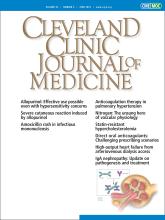An 86-year-old woman presented to the emergency department with fatigue, malaise, a widespread maculopapular rash on the trunk and the extremities (Figure 1), and painful blistering and erosions of the oral mucosa (Figure 2). Medical history was remarkable for hypertension. Medications included amlodipine and allopurinol; the patient started the latter medication for gout 3 weeks before the current presentation.
Widespread maculopapular rash on the trunk (left) and on the legs (right).
Painful blistering and erosions of the oral mucosa.
Laboratory testing revealed leukopenia (white blood cell count 2.85 × 109/L [reference range 3.4–9.6]); elevated serum creatinine (1.7 mg/dL [0.73–1.22]) and blood urea nitrogen (90 mg/dL [8–24]), reflecting dehydration; elevated C-reactive protein (50 mg/L [< 5]); and a normal procalcitonin level (0.02 ng/mL [< 0.05]). Blood and urine cultures were negative. The patient did not have eosinophilia, and alanine transaminase and aspartate transaminase were within normal limits.
Because the rash developed soon after allopurinol was started, we suspected a severe drug cutaneous eruption like Stevens-Johnson syndrome (SJS)/toxic epidermal necrolysis (TEN), a type IV hypersensitivity reaction, and discontinued allopurinol. The patient declined skin biopsy to confirm the diagnosis.
The patient was transferred to the local burn unit, where she was treated with hydration, wound care, artificial nutrition, and intravenous immunoglobulin and did well.
SJS AND TEN
TEN (formerly known as Lyell syndrome) is a rare severe mucocutaneous reaction that manifests as a maculopapular rash with blistering of skin and conjunctival, oral, and genital mucosae. It is defined as detachment of more than 30% of the skin, differentiating it from SJS, which is defined as detachment of less than 10% of the skin. Our patient had SJS/TEN overlap, which is defined as involvement of 10% to 30% of the skin.1
Drug exposure with a subsequent hypersensitivity reaction is the cause of most SJS/TEN cases.1 Current theories about the etiopathology of SJS/TEN point to a portion of the drug molecule (hapten) that is introduced by antigen-presenting cells to T lymphocytes specific for that antigenic pattern. This process triggers a type IV, or delayed, hypersensitivity reaction to the culprit drug after about 2 to 3 weeks of exposure. T lymphocytes infiltrate the skin, producing cytokines and chemokines that are responsible for the clinical manifestations involving the skin and mucosal surfaces.2
Allopurinol as a cause
Allopurinol is one of the most common causes of SJS/TEN. The risk for developing these cutaneous drug reactions is increased when the dosage exceeds 200 mg/day, especially in elderly patients who are treated with 300 mg/day or more.3 Other drugs that may trigger SJS/TEN include antiepileptics (eg, phenytoin, lamotrigine, carbamazepine), sulfonamide antibiotics, and nonsteroidal anti-inflammatory drugs.4
The 2020 American College of Rheumatology guidelines5 conditionally recommend screening for the human leukocyte antigen (HLA)-B*58:01 allele in certain populations before starting allopurinol, as carriers of this allele have a higher risk of TEN than noncarriers. Populations with high allele frequency include people of Han Chinese (10%–15%), Korean (12%), and Thai (6%–8%) ancestry, and African Americans (almost 4%).3
Diagnosis and management
Diagnosis relies mainly on clinical signs. When the diagnosis is not clear, a skin biopsy is indicated for confirmation. Analysis of skin specimens from affected areas typically reveals full-thickness epidermal necrosis.2 Differential diagnoses include linear immunoglobulin A dermatosis, pemphigus, acute generalized exanthematous pustulosis, and staphylococcal scalded skin syndrome.1
The mortality rate in TEN ranges from 25% to 35% due to risk of bloodstream infections and renal failure from loss of fluids from the blisters.2 Aside from suspending the offending drug, treatment of all patients with SJS/TEN includes adequate fluid resuscitation, artificial nutrition (if needed) enriched in protein to help repair skin tissue, pain control, antibiotic therapy in case of sepsis, antithrombotic and gastric ulcer prophylaxis, and the use of nonadherent dressings. Immunomodulatory drugs like cyclosporine have shown some benefit.6 The combination of plasmapheresis and intravenous immunoglobulins may reduce mortality.7 Resolution of the disease can take several weeks.6,7
Avoiding future exposure to drugs of the same pharmacologic class as the drug that triggered SJS/TEN is suggested because there can be cross-reactivity (eg, antiepileptics with aromatic structures such as phenytoin, carbamazepine, and phenobarbital or beta-lactam antibiotics).8
DISCLOSURES
The authors report no relevant financial relationships which, in the context of their contributions, could be perceived as a potential conflict of interest.
- Copyright © 2025 The Cleveland Clinic Foundation. All Rights Reserved.








